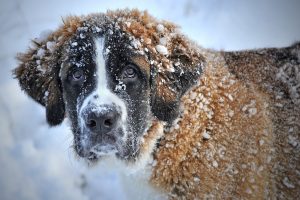Winter Dog Safety Tips For Pet Parents
Before the Christmas songs start playing, and morning walks consist of hot cocoa and parkas, you’ll want to do whatever you can to prepare for the chill of winter – including prepping your dog. Here are some winter safety tips for pet parents.

Clear Paths Can Be Salty
A clear path, like a sidewalk, could be covered in salt. Although it provides you with grip and a melted avenue, your dog, without proper gear, will be walking directly on the salted areas. This can leave your dog in a predicament, as the salt acts as a corrosive irritant to their paws, causing blisters and burns. As well, if they aren’t cleaned appropriately, they could lick their paws and ingest the salt directly, which leads to vomiting or diarrhea. You should do your best to avoid salted areas, or pick up some boots or footpad gear for your pup’s adventures.
Be Aware Of The Limits
While your dog might look like they’re having a great time, you should keep an eye out for symptoms of cold-related injuries. Every dog is resistant to cold, but some can last a lot longer than others. Depending on the breed, size, and age, each dog will have their own limitations to the cold – how long they can be outside for, and how long they can be in direct contact with snow or ice. Do your best to understand your dog’s limits and try to stay within them. If your pup needs a little help, consider a doggie sweater.
Partially Frozen Water and Ice
Dogs seem to love snow, and with your daily walk, you might come across partially frozen water like rivers or lakes. Try to keep your dog away from any unknown areas, as they may be stumbling onto thin ice or hazardous snowbanks. If they tend to bounce around in areas without traction, they could slip, pull a muscle, or tear their skin. Try to keep your walks as safe as possible, and avoid winter hazards.

Skin-Care and Conditions
During the winter months, dogs can develop dry and itchy skin. Try to maintain a regularly scheduled bath that can soothe their skin, as well as keep them warm. If you keep an eye out for products with aloe or oatmeal, that is also natural and gentle, then you will have an ideal product to help assist with your dog’s skincare. Dogs can also develop red areas that are hot to touch, called hot spots. Usually, they develop from moisture being trapped under their fur, commonly found with allergic reactions or excessive licking. Hot spots can be inflamed during the winter. So, speak to your vet about proper treatment during the colder months.
As we might want to stay warm during the winter, your companion doesn’t have much of a choice. It’s your job to keep them safe as their faithful guardian, and of course, have fun! Hopefully, these tips help keep you and your dog safe during the freeze, and of course, Merry Christmas and a Happy New Year!
Article repurposed by: Alyssa Castle
Original Article: Winter Precautions Every Pet Parent Should Remember
